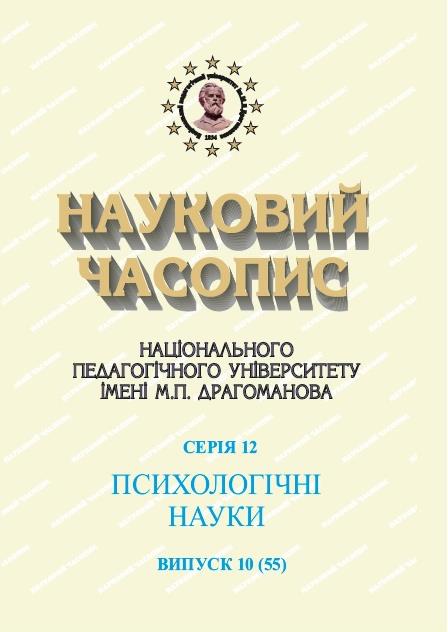STRUCTURAL COMPARISON OF INTELLIGENCE OF POLISH AND AMERICAN CHILDRENS OF MIDCHILDHOOD
DOI:
https://doi.org/10.31392/NPU-nc.series12.2020.10(55).08Keywords:
primary school age, children's intelligence, structure of intelligence, intelligence tests, cross-cultural research WISC, WISC-RAbstract
The present study is devoted to the examination of the factor structure of intelligence measured with WISC and WISC-R derived from the testing of the sample of Polish children. The differences in the structure of intelligence that was measured with WISC and WISC-R (developed by Pietrulewicz) were investigated for a group of 30 Polish fourth-grade students (mean age 10.6). Consistent with the results of a number of other investigations, the results of this study demonstrate the considerable factorial similarity of two scales derived through the use of WISC and WISC-R and these results appear to be consistent with the results of American studies that indicate the superiority of the two-factor solution with non-Anglo-American children. Consistent with American findings, the WISC Verbal, Performance, and Full Scale IQs were higher than those on the WISC-R. On both measures, structural results favor for two-factor solution, which approximates Wechsler’s Verbal and Performance scales. A third factor, failed to simulate Freedom from Distractibility, accounted for approximately 10% of the explained variance. On this factor, Coding was heavily weighted, but Arithmetic and Digit Span loadings ranged from modest to negative. Results provide support for the application of the Wechsler intelligence tests for children in cross-cultural settings and for interpreting the third factor according to the dynamics of specific cultures. Today WISC-R continue to be applied still in Poland for diagnostic and research purposes. Despite limitations of the present study which include the small sample size and the restriction of demographic information to rural-urban differences the results of the present study indicate that replicative studies may clarify further the characteristics of the third factor with varying populations and cultures, while still generating hypotheses with regard to formulations for enhancing learning opportunities for individual children irrespective of their ethnicity or ecological backgrounds.
References
- Bernier, J.J., & Pietrulewicz, B. (2010). La psychometrie traite de mesure appliquee. Montreal-Paris-Casablanca : Gaetan Morin Editeur.
- Carlson, L., Reynolds, C.R., & Gutkin, T.B. (1983). Consistency of the factorial validity of the WISC-R for upper and lower SES groups. Journal of School Psychology, 21, 319-
- Choynowski, M. (1980). Podręcznik do Krótkiej Skali Inteligencji. In Testy psychologiczne w poradnictwie wychowawczo-zawodowym. Warszawa : PWN.
- Evans,J., & Stroebel, S. (1986). A standardization of two measures that supplement WISC-R Coding subtest results. Journal of Clinical Psychology, 42, 654-657.
- Gutkin, T.B., & Reynolds, C.R. (1980). Factorial similarity of the WISC-R for Anglos and Chicanos referred for psychological services. Journal of School Psychology, 18, 34-39.
- Hill, T.D., Reddon, J.R., & Jackson, D.N. (1985). The factor structure of the Wechsler Scales: A brief review. Clinical Psychology Review, 5, 287-306.
- Hillard, G.I. (1979). Standardization and cultural bias as impediments to the scientific study and validation of “intelligence”. Journal of Research and Development in Education, 12, 47-58.
- Kaufman, A.S. (1975). Factor analysis of the WISC-R at 11 age levels between 6 and 16 years. Journal of Consulting and Clinical Psychology, 43, 135-147.
- Kubinger, K.D., Formann, A.K., & Schubert, M. (1980). WISC-R faktor analysis: Untersuchung Zwei und Drei Faktor Ergebnisse. Zeitschrift fur Differentielle und Diagnostische Psychologie. 1, 117-126.
- Larry P. vs. Riles, 343 F. Supp.1306 (N.D. 1972) aff’ d502 F. 2d. 963 (9th Cir. 1974) (Preliminary injunction): No. C-71-2270 RFP slip op. (Oct. 16, 1979) (decision on merits).
- Pietrulewicz, B. (1981). Polska adaptacja Wechsler Intelligence Scale for Children-Revised. Zagadnienia Wychowawcze a Zdrowie Psychiczne, 7, 3-6.
- Reschly, D.J. (1978). WISC-R factor structures among Anglos, Blacks, Chicanos and Native American Papagos. Journal of Consulting and Clinical Psychology, 46, 417-422.
- Reynolds, C. (1980). Differential construct validity of intelligence as popularly measured: Correlations of age with raw scores on the WISC-R for Blacks, Whites, males and females. Intelligence, 4, 374-379.
- Sandoval, J. (1979). The WISC-R and internal evidence of test bias with minority groups. Journal of Consulting and Clinical Psychology, 47, 919-927.
- Sandoval, J. (1982). The WISC-R factorial validity for minority groups and Spearman’s hypothesis. Journal of School Psychology, 20, 198-204.
- Sandoval, J., Zimmerman, I., & Woo-Sam, J. (1983). Cultural differences on the WISC-R verbal items. Journal of School Psychology, 21, 198-204.
- Sattler, J. M. (2018). Assessment of children’s intelligence and special abilities, sixth edition. Boston : Jerome Sattler Editor.
- Silverstein, A.B. (1977). Alternative factor analytic solutions for the Wechsler Intelligence Scale for Children-Revised. Educational and Psychological Measurement, 37, 12-24.
- Snyderman, M., & Rothman, S. (1986). Science, politics and the IQ controversy. Public Interest, 83, 79-97.
- Wechsler, D. (1974). Manual for the Wechsler Intelligence Scale for Children-Revised. New York : Psychological Corporation.

